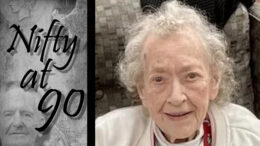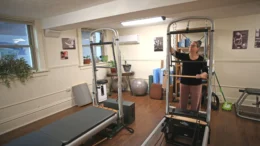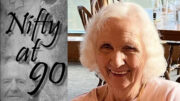DETROIT (AP) — Patricia Hall went to the Auschwitz-Birkenau Museum in 2016 hoping to learn more about the music performed by prisoners in World War II death camps.
The University of Michigan music theory professor heard there were manuscripts, but she was “completely thrown” by what she found in the card catalogs: Unexpectedly upbeat and popular songs titles that translated to “The Most Beautiful Time of Life” and “Sing a Song When You’re Sad,” among others. More detective work during subsequent trips to the Polish museum over the next two years led her to several handwritten manuscripts arranged and performed by the prisoners, and ultimately, the first performance of one of those manuscripts since the war.
“I’ve used the expression, ‘giving life,’ to this manuscript that’s been sitting somewhere for 75 years,” Hall told The Associated Press on Monday. “Researching one of these manuscripts is just the beginning — you want people to be able to hear what these pieces sound like. … I think one of the messages I’ve taken from this is the fact that even in a horrendous situation like a concentration camp, that these men were able to produce this beautiful music.”
Sensing the historical importance of resurrecting music for modern audiences, Hall enlisted the aid of university professor Oriol Sans, director of the Contemporary Directions Ensemble, and graduate student Josh Devries, who transcribed the parts into music notation software to make it easier to read and play.
Last month, the ensemble gathered to record “The Most Beautiful Time of Life” (“Die Schönste Zeit des Lebens”), and it plans to perform the work Friday during a free concert at the university.
Hall believes the piece, a popular fox trot of the day, was performed in 1942 or ’43 by the prisoners in front of the commandant’s villa for Sunday concerts for Auschwitz garrison. Although the prisoners didn’t compose the songs, they had to arrange them so they could be played by the available instruments and musicians.
Based on the prisoner numbers on the manuscript, Hall has so far identified two of the three arrangers: Antoni Gargul, who was released in 1943, and Maksymilian Pilat, released in 1945 and later performed in the Gdansk Symphony Orchestra. They were Polish political prisoners.
The recording will become part of the Auschwitz-Birkenau Museum, which recently obtained a baton of one of the inmate orchestra’s conductors.
While survivors and museum officials have said the musicians received more food, had clean clothes and were spared the hardest labor, museum director Piotr M. A. Cywinski recently said in a statement that they experienced “an element of humiliation and terror.”
Hall said they weren’t immune to the greatest horrors of the camp.
“We like to think of a narrative in which the musicians were saved because they had that ability to play instruments,” she said. “However, it’s been documented by another prisoner (in an orchestra) that around 50 of them … were taken out and shot.”
During 1940-45, some 1.1 million people, mostly Jews, perished in Auschwitz-Birkenau’s gas chambers or from hunger, disease or forced labor.
Hall said it’s a little surprising that no one discovered the manuscripts earlier given their significance, but “not everybody wants to do manuscript study in an archive.” She said she found about eight similar manuscripts that would be worth recording and performing, though it might be for someone else to do.
“Despite everything I do, I find the atmosphere in Auschwitz-Birkenau quite depressing,” she said. “I go back and forth about how much further I’m going to research these manuscripts.”
Still, she said she has been buoyed by the spirit with which her colleagues and students embraced the project.
“It was wonderful to bring it back to this atmosphere with so much positive enthusiasm behind it,” she said. “I thought it was a great idea, but I could imagine talking to someone who said, ‘I don’t really want to perform music from a concentration camp.’ It’s very inspiring for me watching these talented musicians.”































